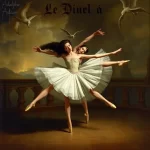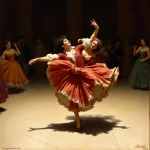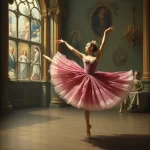Ballet: The Nutcracker (Pyotr Ilyich Tchaikovsky, 1892)

Introduction
Ballet, a classical dance form known for its grace and precision, has produced many iconic works, but few are as beloved as “The Nutcracker.” Composed by Pyotr Ilyich Tchaikovsky and choreographed by Marius Petipa and Lev Ivanov, “The Nutcracker” premiered on December 18, 1892, at the Mariinsky Theatre in St. Petersburg, Russia. This enchanting ballet, based on E.T.A. Hoffmann’s story “The Nutcracker and the Mouse King,” has become a holiday staple, captivating audiences with its magical tale and exquisite music.
Historical Background
Creation and Development
“The Nutcracker” was created during a period of significant artistic and cultural development in Russia. The late 19th century was a time of burgeoning interest in the arts, with ballet becoming increasingly popular. Tchaikovsky, already a renowned composer, was commissioned by the director of the Imperial Theatres, Ivan Vsevolozhsky, to create the score for a new ballet. The inspiration for “The Nutcracker” came from E.T.A. Hoffmann’s 1816 story, which was adapted by Alexandre Dumas père into a more child-friendly version.
The collaboration between Tchaikovsky and choreographers Marius Petipa and Lev Ivanov was crucial to the ballet’s development. Petipa, the principal choreographer of the Imperial Ballet, outlined the libretto and provided detailed instructions for the composition. However, due to illness, Petipa handed over the choreography to his assistant, Lev Ivanov, who brought his own unique vision to the ballet.
Premiere and Reception
“The Nutcracker” premiered on December 18, 1892, at the Mariinsky Theatre in St. Petersburg. The initial reception was mixed; while Tchaikovsky’s score was praised, the choreography and storyline received criticism for being disjointed and lacking in dramatic depth. Despite this, the ballet gained popularity over time, with notable early performances and revivals helping to cement its place in the ballet repertoire.
Synopsis of the Ballet
Act I Summary
The ballet opens on Christmas Eve at the home of the Stahlbaum family. Clara, the young daughter, and her brother Fritz are excitedly preparing for the evening’s festivities. As guests arrive, Clara’s godfather, Drosselmeyer, presents her with a special gift—a nutcracker doll. Fritz, in a fit of jealousy, breaks the doll, but Drosselmeyer repairs it. That night, Clara sneaks downstairs to check on her beloved nutcracker and falls asleep under the Christmas tree.
As the clock strikes midnight, Clara awakens to find herself in a magical world where the Christmas tree has grown, and the nutcracker has come to life. A battle ensues between the nutcracker, leading an army of toy soldiers, and the Mouse King with his army of mice. With Clara’s help, the nutcracker defeats the Mouse King and transforms into a handsome prince. He takes Clara on a journey through the Land of Snow, where they are greeted by dancing snowflakes.
Act II Summary
Clara and the Prince arrive in the Land of Sweets, ruled by the Sugar Plum Fairy. To celebrate their victory over the Mouse King, a series of delightful dances are performed in their honor. These include the Spanish dance (Chocolate), the Arabian dance (Coffee), the Chinese dance (Tea), the Russian dance (Trepak), the Dance of the Reed Flutes, and the Waltz of the Flowers. The Sugar Plum Fairy and her Cavalier perform a grand pas de deux, showcasing their elegance and skill.
Finale
The ballet concludes with Clara and the Prince bidding farewell to the Land of Sweets. Clara awakens back in her home, wondering if her magical adventure was merely a dream. The story’s conclusion leaves audiences with a sense of wonder and enchantment, capturing the timeless magic of “The Nutcracker.”
Musical Composition
Composer’s Role
Pyotr Ilyich Tchaikovsky, one of the most celebrated composers of the Romantic era, played a pivotal role in the creation of “The Nutcracker.” His score is renowned for its melodic richness and orchestral color. Notable pieces within the score include the “Dance of the Sugar Plum Fairy,” “Waltz of the Flowers,” and the “March.” Tchaikovsky’s use of the celesta in the “Dance of the Sugar Plum Fairy” was innovative, adding a magical, ethereal quality to the music.
Musical Themes and Motifs
Tchaikovsky’s score for “The Nutcracker” is characterized by recurring musical themes and motifs that enhance the narrative and emotional depth of the ballet. The use of leitmotifs, such as the Nutcracker’s theme and the Mouse King’s theme, helps to establish character identities and drive the story forward. The music’s ability to evoke a wide range of emotions, from the excitement of the battle scene to the serene beauty of the Land of Snow, is a testament to Tchaikovsky’s genius.
Famous Recordings and Performances
Over the years, “The Nutcracker” has been recorded and performed by numerous renowned orchestras and ballet companies. Iconic recordings include those by the New York City Ballet Orchestra conducted by Robert Irving and the Royal Philharmonic Orchestra conducted by Yuri Simonov. Notable performances include those by the Bolshoi Ballet, the Mariinsky Ballet, and the New York City Ballet, each bringing their unique interpretation to this timeless classic.
Choreography and Dance
Choreographer’s Vision
Marius Petipa’s vision for “The Nutcracker” was rooted in the classical ballet tradition, emphasizing precision, grace, and storytelling through dance. Lev Ivanov, who took over the choreography due to Petipa’s illness, brought a more lyrical and expressive style to the ballet. Ivanov’s choreography for the snowflakes and the various character dances in the Land of Sweets remains iconic, showcasing his ability to blend technical skill with emotional expression.
Signature Dance Numbers
“The Nutcracker” features several signature dance numbers that have become synonymous with the ballet. The “Pas de Deux” between the Sugar Plum Fairy and her Cavalier is a highlight, showcasing the dancers’ technical prowess and emotional connection. Other key dances include the “Waltz of the Flowers,” the “Dance of the Sugar Plum Fairy,” and the various character dances representing different countries and cultures. Each dance reflects the story’s themes of wonder and celebration.
Notable Interpretations
Over the years, different productions of “The Nutcracker” have brought unique interpretations to the choreography. George Balanchine’s 1954 production for the New York City Ballet is one of the most famous, known for its lavish sets and costumes and its emphasis on the role of children in the ballet. Other notable interpretations include those by Rudolf Nureyev, who added a darker, more psychological dimension to the story, and Matthew Bourne, who reimagined the ballet with a contemporary twist.
Characters and Roles
Main Characters
- Clara: The young heroine of the story, Clara is curious, brave, and kind-hearted. Her journey through the magical world of “The Nutcracker” represents a rite of passage from childhood to adolescence.
- The Nutcracker/Prince: Initially a wooden nutcracker doll, he transforms into a handsome prince after defeating the Mouse King. He serves as Clara’s guide and protector in the magical world.
- Drosselmeyer: Clara’s mysterious godfather, Drosselmeyer is a skilled magician and inventor. He orchestrates much of the magic in the story, including the transformation of the nutcracker.
- Sugar Plum Fairy: The benevolent ruler of the Land of Sweets, she welcomes Clara and the Prince and organizes a celebration in their honor.
Supporting Characters
- Fritz: Clara’s mischievous younger brother who breaks the nutcracker doll out of jealousy.
- Mouse King: The antagonist of the story, he leads an army of mice in a battle against the nutcracker and his toy soldiers.
- Various Dancers: Representing different countries and cultures, these characters perform the delightful dances in the Land of Sweets.
Famous Dancers
Many renowned dancers have portrayed the roles in “The Nutcracker” over the years. Notable performers include Rudolf Nureyev and Mikhail Baryshnikov as the Nutcracker/Prince, and Margot Fonteyn and Gelsey Kirkland as Clara. These dancers have brought their unique artistry and interpretation to the ballet, contributing to its enduring legacy.
Cultural and Artistic Impact
Influence on Ballet and Dance
“The Nutcracker” has had a profound influence on ballet and dance, inspiring countless choreographers and dancers. Its success helped to popularize ballet in the United States, where it has become a holiday tradition. The ballet’s emphasis on storytelling through dance has influenced other works, encouraging choreographers to explore narrative-driven ballets.
Cultural Significance
Beyond its impact on ballet, “The Nutcracker” holds a special place in popular culture. It has been adapted into numerous films, television specials, and stage productions. The ballet’s music, particularly the “Dance of the Sugar Plum Fairy” and the “Waltz of the Flowers,” is instantly recognizable and often used in holiday advertisements and events.
Legacy and Revivals
“The Nutcracker” continues to be performed and celebrated around the world. Major revivals and reinterpretations, such as those by George Balanchine and Matthew Bourne, have kept the ballet fresh and relevant for new generations. Its enduring popularity ensures that it remains a beloved holiday tradition and a cornerstone of the ballet repertoire.
Iconic Productions
Historic Productions
One of the most famous historical productions of “The Nutcracker” is George Balanchine’s 1954 version for the New York City Ballet. This production is known for its elaborate sets and costumes, as well as its emphasis on the role of children in the ballet. Other notable historical productions include those by the Bolshoi Ballet and the Mariinsky Ballet, which have brought their own unique interpretations to the classic work.
Contemporary Productions
Recent productions of “The Nutcracker” have continued to innovate and reinterpret the ballet. Matthew Bourne’s 1992 production, for example, reimagined the story with a contemporary twist, incorporating modern dance elements and a darker, more psychological narrative. Other contemporary productions have experimented with different settings and cultural influences, showcasing the ballet’s versatility and timeless appeal.
Production Design
The set, costume, and lighting design in various productions of “The Nutcracker” play a crucial role in bringing the magical world to life. From the opulent Victorian-era sets of Balanchine’s production to the whimsical and fantastical designs of more modern interpretations, each production’s design elements contribute to the overall atmosphere and storytelling. The use of innovative lighting techniques and special effects further enhances the ballet’s enchanting quality.
Critical Reception and Reviews
Initial Critical Response
At the time of its premiere, “The Nutcracker” received mixed reviews. While Tchaikovsky’s score was praised for its beauty and inventiveness, the choreography and storyline were criticized for being disjointed and lacking in dramatic depth. Some critics found the ballet’s emphasis on spectacle over narrative to be a weakness.
Modern Reviews
In contrast to its initial reception, “The Nutcracker” is now widely regarded as a masterpiece. Contemporary critics and audiences appreciate the ballet’s enchanting music, intricate choreography, and timeless story. Its enduring popularity is a testament to its ability to captivate and inspire audiences of all ages. The ballet’s relevance today is reflected in its continued performances and adaptations around the world.
Fun Facts and Trivia
Behind-the-Scenes Stories
One interesting behind-the-scenes story involves Tchaikovsky’s use of the celesta in the “Dance of the Sugar Plum Fairy.” The composer discovered the instrument during a visit to Paris and was so taken with its sound that he decided to incorporate it into the ballet. He kept its use a secret until the premiere to surprise audiences with its unique, ethereal quality.
Notable Performers
Over the years, many famous dancers, conductors, and directors have been associated with “The Nutcracker.” Rudolf Nureyev and Mikhail Baryshnikov are among the notable dancers who have portrayed the Nutcracker/Prince. Renowned conductors such as Leonard Bernstein and Seiji Ozawa have also contributed to iconic recordings of the ballet’s score.
Trivia
- The original production of “The Nutcracker” featured children from the Imperial Ballet School in many of the roles, a tradition that continues in many productions today.
- Tchaikovsky was initially reluctant to compose the score for “The Nutcracker,” as he found the story less compelling than his previous ballet, “The Sleeping Beauty.”
- The “Waltz of the Flowers” is one of the most frequently performed pieces from the ballet and is often featured in concert programs and holiday events.
Conclusion
Summary of the Ballet’s Importance
“The Nutcracker” holds a special place in the world of ballet and dance. Its enchanting music, intricate choreography, and timeless story have made it a beloved holiday tradition and a cornerstone of the ballet repertoire. The ballet’s influence on other works and its role in popularizing ballet in the United States further underscore its significance.
Final Thoughts
Reflecting on “The Nutcracker,” it is clear why this ballet continues to captivate audiences around the world. Its magical blend of music, dance, and storytelling creates an unforgettable experience that resonates with people of all ages. Whether you are a seasoned ballet enthusiast or a newcomer to the art form, “The Nutcracker” offers a delightful journey into a world of wonder and enchantment. I encourage readers to watch a performance or listen to the score to fully appreciate the beauty and magic of this timeless classic.
FAQ
What is the central theme of this ballet?
The central theme of “The Nutcracker” is the journey from childhood to adolescence, represented through Clara’s magical adventure. The ballet also explores themes of wonder, imagination, and the triumph of good over evil.
Who are the main characters in this ballet?
The main characters in “The Nutcracker” are Clara, the Nutcracker/Prince, Drosselmeyer, and the Sugar Plum Fairy. Each character plays a crucial role in the unfolding of the magical story.
What is the most famous dance number in this ballet?
One of the most famous dance numbers in “The Nutcracker” is the “Dance of the Sugar Plum Fairy,” known for its delicate and ethereal quality. Other notable dances include the “Waltz of the Flowers” and the various character dances in the Land of Sweets.
How long does a typical performance of this ballet last?
A typical performance of “The Nutcracker” lasts approximately two hours, including an intermission. The ballet is usually performed in two acts.
Are there any modern adaptations of this ballet?
Yes, there are several modern adaptations of “The Nutcracker.” Notable examples include Matthew Bourne’s contemporary reimagining and various film adaptations that bring new perspectives to the classic story.
Why is this ballet considered important in the history of dance?
“The Nutcracker” is considered important in the history of dance due to its enduring popularity, its influence on other works, and its role in popularizing ballet in the United States. The ballet’s innovative choreography and Tchaikovsky’s iconic score have made it a timeless masterpiece that continues to inspire dancers and choreographers around the world.





